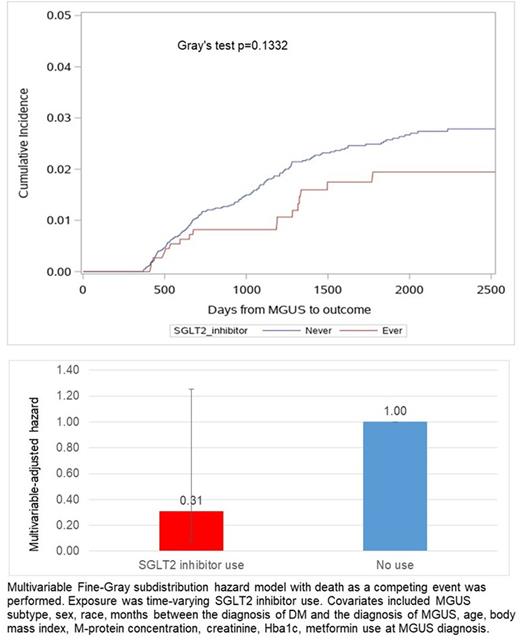Abstract
Background: SGLT2 inhibitors (Canagliflozin, Dapagliflozin, and Empagliflozin) are antidiabetic medications that have been demonstrated to have cardio- and nephron- protective effects. Pre-clinical studies have demonstrated tumor suppressive effects in gastrointestinal and prostate cancers. SGLT2 inhibitors have not been studied in Monoclonal Gammopathy of Undetermined Significance (MGUS) or Multiple Myeloma (MM). We aimed to assess the association between SLGT2 inhibitor use and the progression of MGUS to MM in patients diagnosed with MGUS and a prior diagnosis of diabetes mellitus (DM) using the nationwide U.S. Veterans Health Administration database.
Methods: Veterans diagnosed with MGUS between October 1, 1999, and December 31, 2021 were identified. A natural language processing algorithm was used to confirm MGUS diagnosis and progression to MM. Because SGLT2 inhibitors were approved as new treatments for DM after 2013, our analysis included patients who were diagnosed with MGUS after 2014 with a prior diagnosis DM. We excluded patients diagnosed with MGUS prior to DM and patients who progressed ≤ 1 year of MGUS diagnosis or ≤2 years of DM diagnosis. The outcome was MGUS progression with a maximum follow-up of 7 years after MGUS diagnosis. Cumulative incidence functions stratified by SGLT2 inhibitor use status (ever vs never use) were plotted. Gray's test was performed to detect the difference between the two functions. The association between SGLT2 inhibitors (time-varying depending on medication dispense) and progression was analyzed using a multivariable Fine-Gray subdistribution hazard model with death as a competing event.
Results: Our NLP algorithm confirmed 17,969 patients with MGUS and DM. After applying our inclusion and exclusion criteria, the analytic cohort included 7,568 patients, of which 1,115 patients ever used SGLT2 inhibitors. The cumulative incidence functions stratified by SGLT2 inhibitors ever use status are separate (see figure) but not statistically significant (p = .1332). The multivariable analysis demonstrated that SGLT-2 inhibitor was inversely related with progression to MM (multivariable-adjusted hazard ratio 0.31, 95% confidence interval 0.08-1.25, p = 0.10).
Conclusions: In patients with MGUS, SGLT2 inhibitor use is associated with non-statistically significant trend towards decreased progression to MM. Further clinical studies are warranted to examine whether SGLT2 inhibitors can be used as potential chemoprevention agents in MGUS patients.
Disclosures
Sanfilippo:ACS-IRG: Research Funding; Covington & Burling LLP: Other: Expert Case Review; Health Services Advisory Group: Consultancy; K01 NHLBI: Research Funding; NHLBI NIH: Other: Loan Repayment program; Quinn Johnston: Other: Expert Case Review.
Author notes
Asterisk with author names denotes non-ASH members.


This feature is available to Subscribers Only
Sign In or Create an Account Close Modal